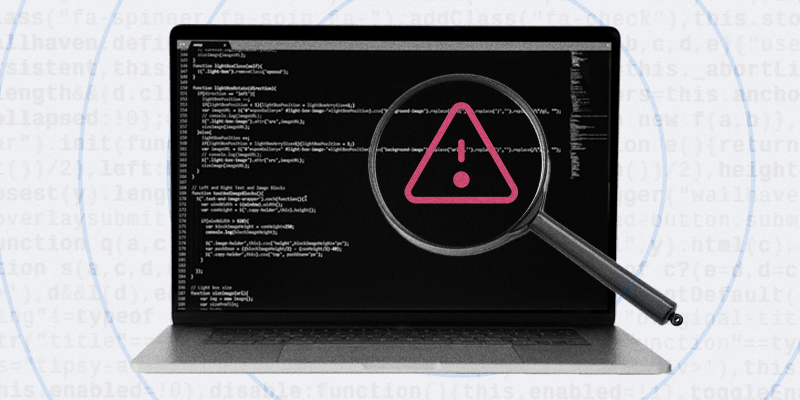
Why Visibility Is a Major Salesforce Data Issue

A lack of visibility for DevOps in Salesforce leads to data issues that can result in security vulnerabilities, costly mistakes, and compliance concerns.
Why It Matters: Data integrity impacts every function of your Salesforce environment. Failing to properly protect and maintain your data can have wide-ranging impacts, including disastrous results if the proper levels of care aren’t taken.
- Bad data costs companies between 15% and 25% of their annual revenue.
- Unseen problems exacerbate costly losses.
- Long-standing issues have the potential to create compliance failures.
Here are 9 reasons visibility is important for DevOps in Salesforce:
- You Can’t Fix a Problem You Don’t See
- Data Issues Grow Over Time
- Improper Settings Lead to Data Loss
- Contemporary Insights Are Most Relevant
- Data Security Issues Are Often Hidden
- Collaboration Requires Transparency
- Clarity Increases Productivity
- Compliance Audits Need Clear Trails
- Easily Found Changes are Easier to Track and Manage
1. You Can’t Fix a Problem You Don’t See
Many Salesforce DevOps issues exist in the background. When a car has an issue, a warning light might come on or maybe the car won’t start. It’s easy to know when it’s time to call a mechanic and address a problem. IT systems aren’t always as transparent. Data issues can corrupt your system without being noticeable for a long time.
Visibility enables teams to notice irregularities that point to data issues so they can be addressed and rectified.
Automated testing and strong data governance policies provide the coverage you need to find and fix data issues.
2. Data Issues Grow Over Time

Every Salesforce DevOps project is the product of a series of interrelated data contingencies. Getting something wrong at the very outset of the application lifecycle will create a snowball effect that impacts other areas of the update. Duplicate records, outdated information, and incomplete data all lead to other data difficulties.
Unaddressed issues create unnecessary complications that can result in redundant work, lost time, and even data security issues.
Having visibility into code health from the outset of development enables teams to fix any coding issues the moment they occur, preventing costly errors that compromise the entire application. Static code analysis is a critical part of a complete Salesforce DevOps strategy.
3. Improper Settings Lead to Data Loss
Profile and permission settings aren’t always considered a threat to data integrity. However, improper settings have the potential to drastically increase the likelihood of costly mistakes occurring that erase, compromise, or expose sensitive system data.
The inability to verify proper permission settings across an organization leads to overexposure and a higher risk of incurring accidental deletions or other data issues.
An automated policy scanner enables Salesforce administrators to maintain contemporary snapshots of who can see which types of data. Ensuring proper settings is a critical part of protecting system data and supporting proper security measures.
4. Contemporary Insights Are Most Relevant

The data that drives business decisions is only as useful as it is current. Outdated insights fail to provide the context organizations need to refine processes, anticipate customer needs, and find issues requiring an update. Having the ability to harness contemporary data and package it in an understandable format will highlight critical insights to capture.
Reports and dashboards offer visibility into current processes and market trends that organizations can use to find the most beneficial path forward.
Automated release management, static code analysis, and other Salesforce DevOps tools offer the ability to schedule reports for easily digestible, current insights.
5. Data Security Issues Are Often Hidden
On average, it takes 287 days to detect and fix a data breach. Hackers don’t announce themselves when they find their way into your system. Technical debt sits in live environments with the potential to create data security risks through misfires and errors. But these issues can only be located if you are looking for them.
Performing frequent scans and implementing a strong Salesforce DevOps strategy provide the visibility teams need to both prevent data security vulnerabilities and expose leaks as soon as they occur.
Analyzing access logs, running reports on data exports, and conducting comprehensive code reviews all provide key indicators of the health of your Salesforce environment.
6. Collaboration Requires Transparency
Salesforce DevOps requires the harmonious work of numerous teams over the course of a single project. Everyone from administrators and developers to the QA and deployment teams all need to be on the same page. Failing to facilitate strong collaboration between teams creates confusion and leads to issues that degrade the quality of data.
Open collaboration between teams requires visibility into the status of an update at all stages of the Salesforce DevOps pipeline.
There shouldn’t be any surprises as a project moves from one stage to the next. Streamlined communication reduces errors and makes for a better working experience.
7. Clarity Increases Productivity

Easy access to insights and information reduces confusion, which is a main driver of errors. Mistakes at any stage of the application lifecycle mean the following team will be getting something they weren’t expecting. This leads to lost time when confusion causes questions that eventually require redundant work.
A clear view of a DevOps project is only possible when automated testing and open communication ensure there are no hidden surprises in an application or update.
Allowing your DevOps teams to move a project forward instead of constantly reworking things means your release velocity increases alongside your yearly capacity for releases.
8. Compliance Audits Need Clear Trails
Visibility into Salesforce processes has to extend outward for organizations in regulated industries. Neglecting to document critical processes can lead to a series of problems when a compliance auditor needs to verify adherence to regulations.
Documented trails of how data has been handled and managed need to be maintained to prove an organization’s continued compliance with applicable regulations.
A policy scanner can be used to both verify proper practices for data management and compile metrics for proving compliance. This and other DevOps tools provide the visibility needed to satisfy regulatory auditors.
9. Easily Found Changes are Easier to Track and Manage

Salesforce environments evolve over time as a company grows. Updates, integrations, new processes—any of these has the potential to impact functionality, security, and quality. But if these changes aren’t tracked and maintained over time, disruptions can occur.
Constant oversight of platform changes makes them much easier to manage and resolve identified gaps in functionality.
Change management is an essential aspect of Salesforce DevOps and needs to be addressed in order to maintain a healthy environment.
Next Step…
AutoRABIT recently introduced a new product that takes visibility to a new level for DevOps in Salesforce. FlowCenter offers a visual interface for a no code, drag-and-drop approach to application lifecycle management.
Check out the datasheet here for more information on this leap forward in DevOps visibility.
FAQs
What is meant by “visibility” in DevOps for Salesforce?
Do you know what’s going on in your Salesforce environment? Who is accessing what files and when? Exactly who has access to your platform in the first place? These types of considerations help you understand the current state of your IT environment. And the more insight you have into who is accessing your data, why, and when, the more visibility you have. Visibility refers to the ability to gain insight and understanding into various aspects of the software development and deployment processes within the Salesforce environment. There are a variety of ways you can increase visibility—both through proper processes and automated tools. It’s in every organization’s best interest to increase visibility into their DevOps environment as much as possible.
Why are bugs more expensive the later you find them in the DevOps pipeline?
A piece of code joins with other pieces of code to build functionality. And as a DevOps project progresses toward deployment, the dependencies within the coding structures become more intricate and complicated. A small coding error that isn’t fixed for a while can become entwined with other pieces of code. Undoing this work results in a lot of redundant work to get the project back to baseline after removing the error. This time is wasted, which also equates to money in a business environment. Errors that result from bugs that make it into a live environment also factor into the overall cost associated with the deployment. Fixing these bugs before they move deeper into the DevOps pipeline with a static code analysis tool is essential for streamlining development efforts.
How do I maintain quality data in Salesforce?
High-quality data informs stronger business decisions, heightens accountability, and reinforces data security measures. But strong data is no accident—it takes continuous attention. Data governance is the process of maintaining a quality pool of data through intentional practices and tools. This requires organizations to put together data governance teams and a strategy that should be updated over time as challenges and successes are seen. Visit our blog here to learn more about the steps to achieve a robust data governance strategy. Strong Salesforce data makes it much easier to streamline processes, reduce confusion, and remain secure.

